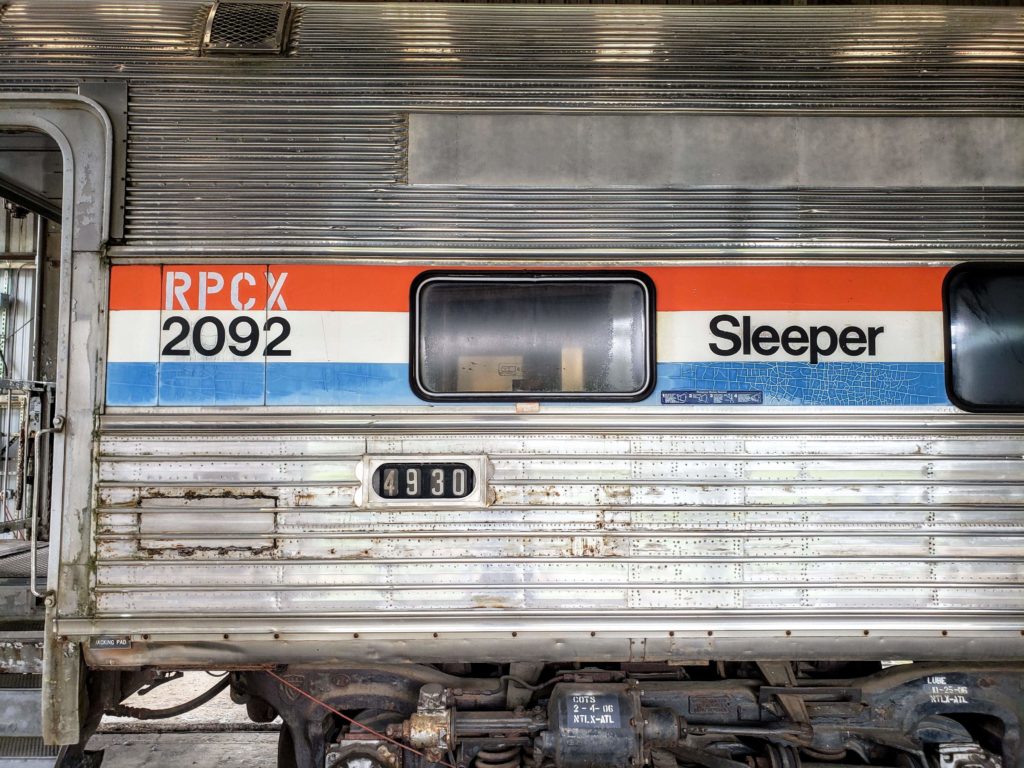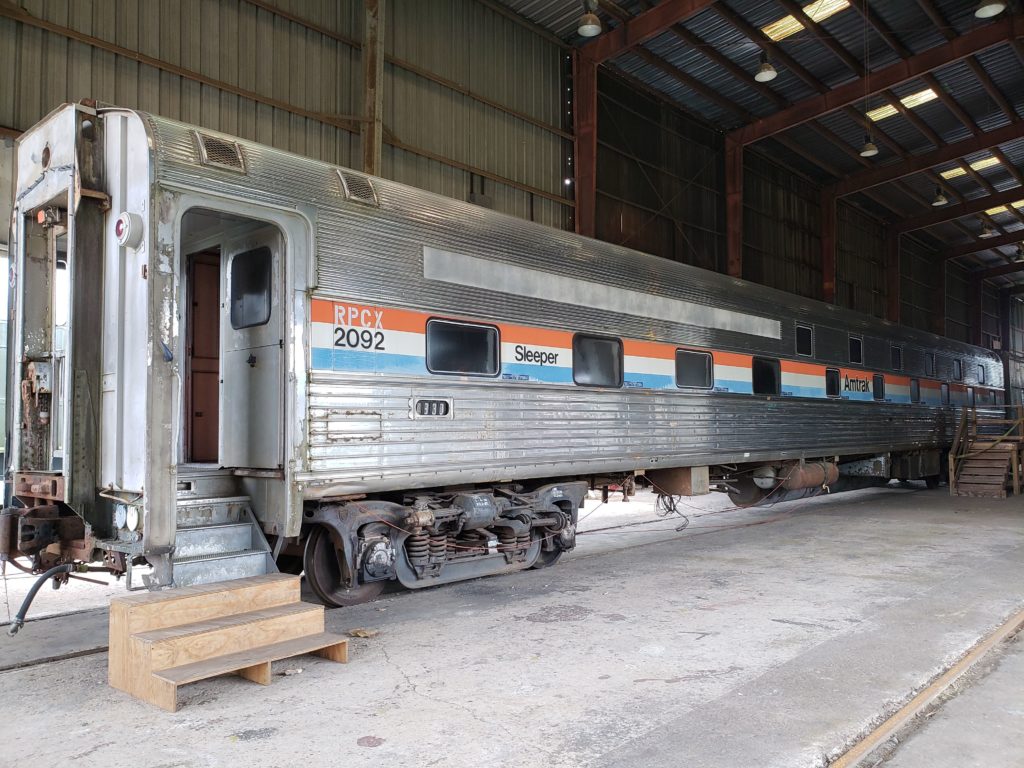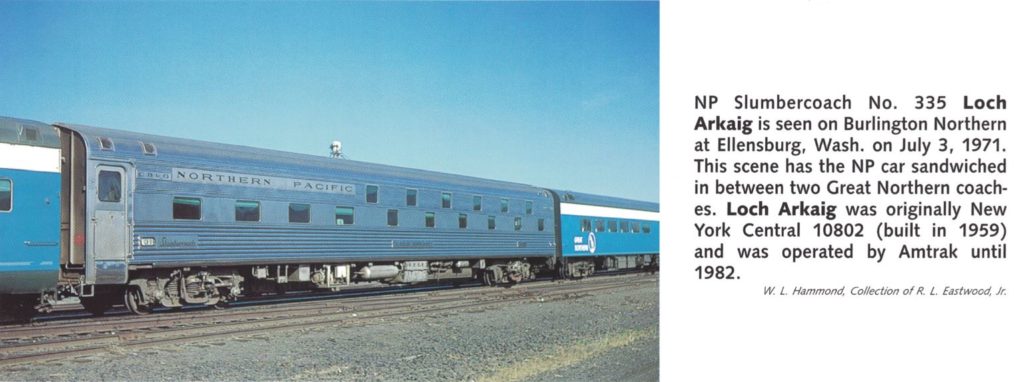Built by Budd for the New York Central in 1959, Amtrak Slumbercoach 2092 at the Southeastern Railway Museum was one of an order of 12 built for Northern Pacific (4), Missouri Pacific (1), Baltimore & Ohio (3), and New York Central (4) in Lot 9691-090, Pullman Plan 9540. The car was built as a 24 single-room, 8 double-room slumbercoach. On the New York Central, the car was numbered 10802, and when it was acquired in 1964 by Northern Pacific and was named Loch Arkaig #335. In 1971, the car was acquired by Amtrak and remained in service until retired in the mid 1990s. In 1998 the car was sold to Don Williams who stored it at Pullman Yard in Atlanta until he donated it to the Southeastern Railway Museum in 2006.
Below is more in-depth information on the slumbercoach.
The Budd Slumbercoach Brings Economy to Pullman Passengers
by Tom Smith
NRHS Bulletin, Summer 2006
America’s railroads and their suppliers endeavored to combat the decline in passenger boardings in the 1950s by efforts that were aimed more at reducing expenses than increasing revenue, and were phenomenally unsuccessful, such as the Aerotrain, Xplorer, and so forth. But one innovation from that period succeeded at both, and that was the Budd-built Slumbercoach.
In my opinion, the Slumbercoach was the most innovative development in passenger railroading in the postwar period, save the Vista Dome. More than just updating existing technology, it gave long distance passengers a totally new kind of accommodation and a reason to ride the rails, as well as giving the carriers one of their few competitive edges against the growing competition. Unfortunately, not enough of them were built to make much difference.
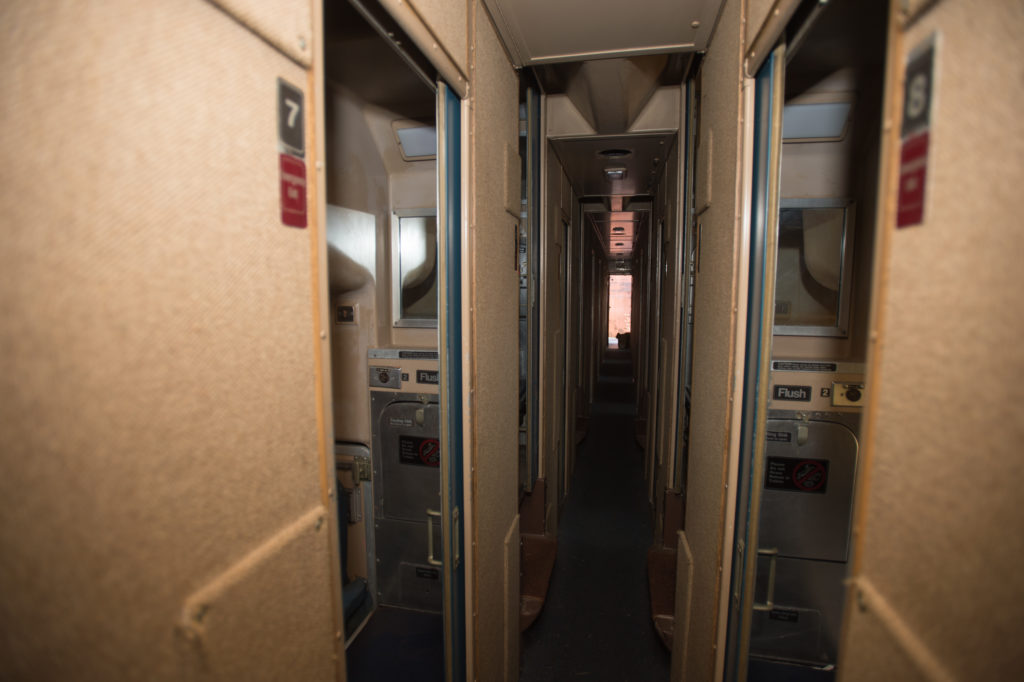
The Slumbercoach featured both single and double types of rooms. Double rooms were about the size of a standard roomette, with two seats facing each other, and a hinged upper berth above, similar in arrangement to an Amtrak Superliner standard bedroom. At night, the seats folded down, and two doors behind the seats opened to form a bridge on which the bedding was placed. The upper berth folded down. The single room provided a seat for day use that also folded out of the way at night, and again two fold-down doors formed a platform on which bedding was rolled out from one of the wells to form the bed. The bedding was pre-made by the porter, and the passenger was given instruction to prepare his own room for sleeping, although the porter was always available to help. Each room had its
own fold-down wash basin and a toilet. Single rooms were in a duplex arrangement to conserve space, with slightly different arrangements for the berths in the upper and lower rooms. The bed in the lower room was just above the floor, while the upper room bed was just above the window. Interiors were formed of two sections of molded pink fiberglass, and had two reading lights and chrome handrails.
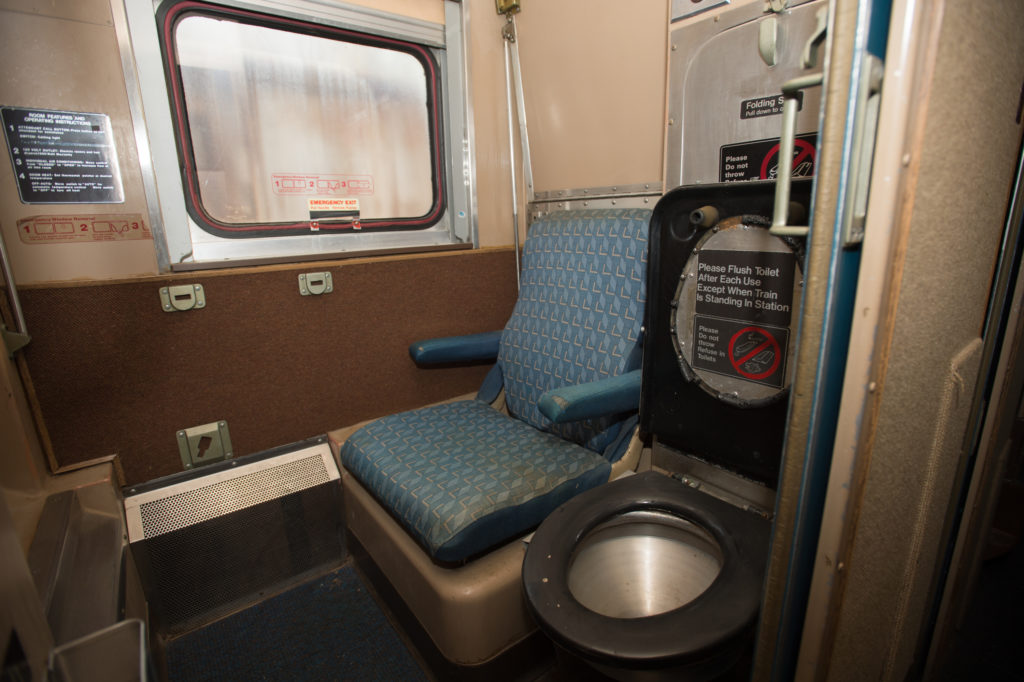
Slumbercoach passengers did not enjoy luxury. Seats were small, the beds narrow, and there was little legroom in which to stretch out. But they did have privacy, and a real bed in which to sleep. Most of all, they could save money. A Slumbercoach passenger paid only a small room accommodation charge on top of a coach ticket.
The decline in long-haul passenger traffic following World War II hit Pullman travel quickly and especially hard. Although coach travel held on due to its economy, Pullman traffic was adversely affected not only by its inability to compete with the airlines on speed, but also by high cost. For example, in 1956 a Baltimore & Ohio passenger would pay $27.21 to travel between Washington and Chicago in a coach seat, but a roomette would have cost $48.63, including a $12.40 Pullman accommodation charge on top of a $36.23 first-class rail ticket. After the Slumbercoach was introduced, a traveler would pay only the $6.00 accommodation
charge above the coach fare, about two-thirds the cost of a standard roomette.
Most standard lightweight Pullman sleepers could accommodate 22 passengers. Because of the compact nature of the Slumbercoach design, a fully occupied Slumbercoach could accommodate 40 passengers, giving the railroads virtually the same revenue-producing ability as the long distance 44-seat coach, and allowing the passenger to pay the cheaper coach fare instead of the first-class rail fare. The Slumbercoach was aimed at a market the railroads were rapidly losing: the passenger who wanted to take the train for convenience or safety, did not want to sit up all night in a coach, and did not desire — or wish to pay for — first-class Pullman service. Slumbercoaches proved immensely popular wherever they were introduced, bringing in new business while retaining the old, until they made their last runs for Amtrak in the mid-1990s.
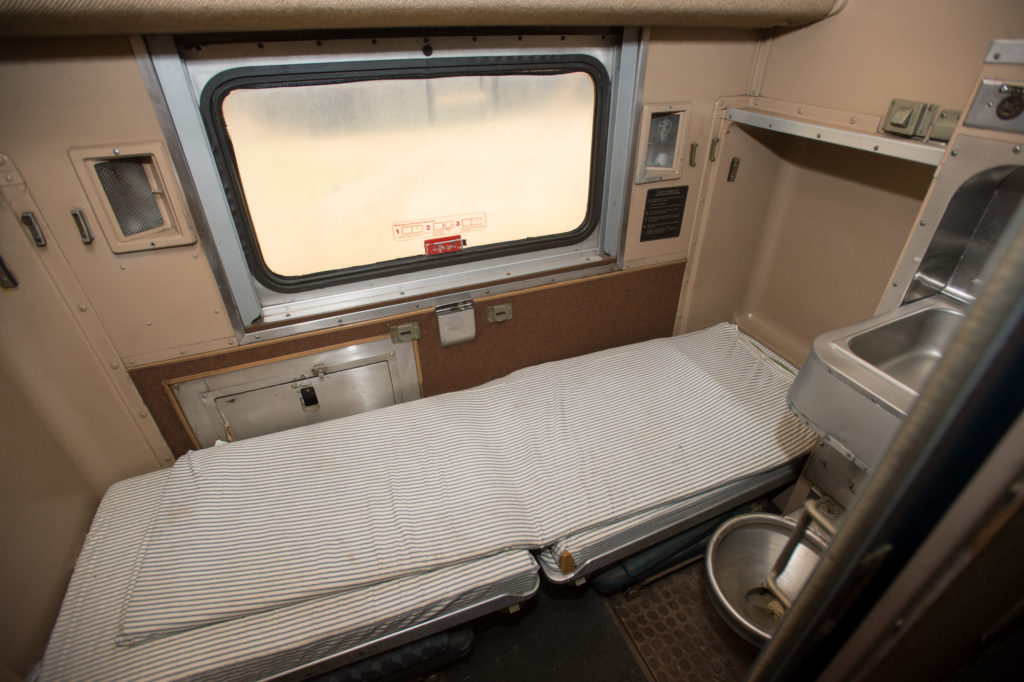
[…]
The first four Slumbercoaches were delivered to the Burlington in late 1956 as part of two completely new Budd-built trainsets that would replace the original 1936 articulated Denver Zephyr trainsets. Each Slumbercoach had 24 duplex single rooms and eight double rooms. Two cars were assigned to each trainset, one operating to Denver and the other continuing to Colorado Springs, in a through-car arrangement handled beyond Denver by D&RGW’s Royal Gorge.
In 1958, two more Slumbercoaches were delivered to the B&O and assigned to the Columbian between Baltimore and Chicago. It is interesting to note that after the all-coach Columbian and all-Pullman Capitol Limited were combined, the Slumbercoach became part of the coach train.
Budd must have thought it had a winner in the Slumbercoach, but orders were not coming in from the railroads, which apparently lacked the faith in the long-distance market that Budd had. Budd built the final 12 Slumbercoaches in 1959, which enjoyed the distinction of being the last new Pullman cars built. These 12 cars were leased to the railroads on which they ran, saving the railroads a capital expenditure. Three cars went to the B&O, which assigned them to the Baltimore-St. Louis National Limited. A single car went to the Missouri Pacific, which in conjunction with the three B&O cars inaugurated a through Slumbercoach between Baltimore and San Antonio, using the Texas Eagle beyond St. Louis.
Four cars were leased to New York Central, which assigned two to each consist of the Twentieth Century Limited. NYC had ended Pullman operation on intra-line sleeping cars a year earlier, so those four cars were not operated by Pullman as the others were. Finally, the remaining four cars went to the Northern Pacific, which assigned them to the North Coast Limited. It took five cars to equip the North Coast Limited, but an arrangement with partner Burlington allowed one of the Denver Zephyr cars to cycle to Seattle in a pool that saved one car.
New York Central, which in the late 1950s was rapidly retrenching in the passenger business and selling scores of surplus Pullman cars to Canada and Mexico, must have been impressed by the public’s acceptance of the “Sleepercoach,” as NYC called it, and added ten more cars to its fleet in 1961. To save the expense of buying new cars, these ten cars were created by sending surplus Budd-built 22-roomette sleepers back to Budd where the interiors were stripped and Slumbercoach interiors installed. In order to make as much use of the existing windows as possible, the converted cars featured ten double rooms and 16 singles. Twelve of the singles were duplex rooms nearly identical to those in existing Slumbercoaches, but four of the single rooms used existing windows and were on a single level, giving the passenger more room. I tried to request those rooms when I could.
The NYC assigned its new cars to runs serving Boston, Detroit, Cincinnati, and Cleveland, and aggressively promoted the service. In 1964, all 12 of the leased cars were sold to Northern Pacific, which added them to their secondary train, the Mainstreeter. This event brought the four NYC cars under Pullman operation, and they were given names. A year later, two of the former NYC cars were transferred from NP to the Burlington, most likely to better balance the pool. […]
To read the rest of the article, see the NRHS Bulletin on Slumber Coaches. This article is provided with permission of the National Railway Historical Society and should not be redistributed or reproduced without permission.

